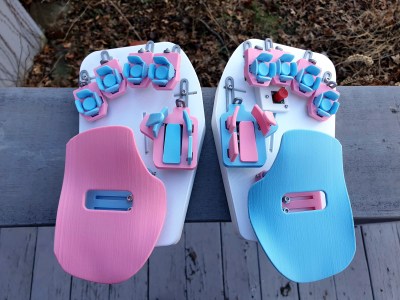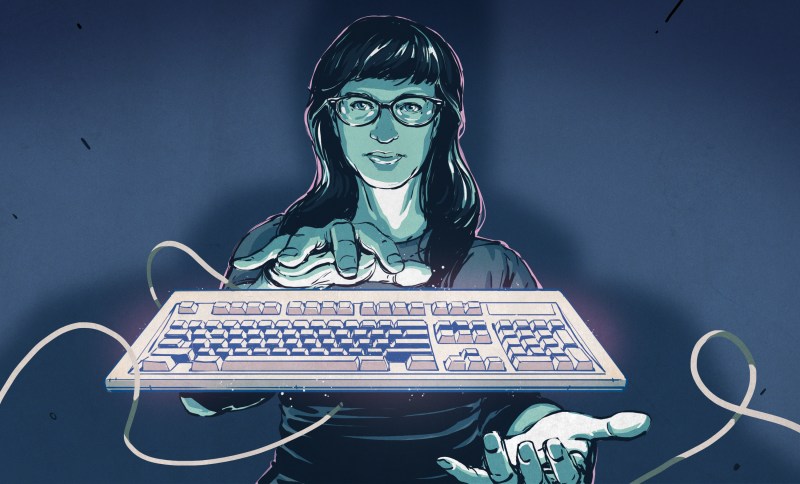When you find something you love doing, you want to do it everywhere, all the time. Such is the case with [jefmer] and programming. The trouble is, there is not a single laptop or tablet out there that really deals well with direct sunlight. So, what’s a hacker to do during the day? Stay indoors and suffer?

The miniature PocketType 40% is a little small for touch typing, but facilitates thumbs well. [jefmer] added those nice vinyl transfer legends and sealed them with clear nail polish.
All of the software including the keyboard scanner is written in Espruino, which is an implementation of JavaScript that targets embedded devices. Since it’s an interpreted language, [jefmer] can both write and execute programs directly on the Pocket Pad, using the bottom screen for the REPL. I’d sure like to have one of these in my pocket!
A Love Connection

One day ten years ago, Aaron Therol fell in love while taking out the trash. Someone had thrown a 1950s Royal typewriter in the Dumpster, which Therol initially mistook for an empty suitcase.
This inciting incident led to Aaron opening Typewriter Connection, a 400 square foot typewriter shop in downtown Los Angeles that rent, sells, and repairs the machines.
The store is crammed with dozens of specimens dating as far back as 1898, and visitors are invited, nay, encouraged to play with them. After all, regular use is what keeps them in clacking order.
Therol specializes in older models, from the turn of the century to the turn of the plastic in the 1960s. In addition to being a salesman, he is also the designated typewriter repair person for one Tom Hanks, who writes short stories on his collection of hundreds of typewriters. LA has a whole typewriter scene, you see, and Therol also hosts what I’m sure is one of many type-ins around town. Darn my Midwestern contentment. Maybe I should host a type-in here?
The Centerfold: A New Setup for 2024

Do you rock a sweet set of peripherals on a screamin’ desk pad? Send me a picture along with your handle and all the gory details, and you could be featured here!
Historical Clackers: the Bennett Typewriter

Well, isn’t this the cutest typewriter you ever saw? About the size of a box of chocolates, the Bennett typewriter holds the honor of being the smallest keyboard typewriter ever built. I suppose that’s as opposed to an index typewriter, the prime modern example being the embossing-style label maker.
This 1910 typewriter originally sold for $18, which equates to about $567 in 2024. Other machines of this era like the Oliver No. 5 for example typically sold for $65-$125, so the Bennett was as economical as it was portable.
One of the great things about this typewriter is that the elements are cylindrical, so they can easily be swapped for other fonts. There are some interesting things to note about the key layout: space is on the top row and T and Y are on the home row, which forces G and H into the bottom row. That had to be at least a little bit confusing.
ICYMI: Calling All RSI Sufferers
 If you’ve heard of the DataHand keyboard, then this may look familiar. This is the Svalboard, [Morgan Venable]’s recreation of a popular-among-users keyboard that saved many RSI sufferers a lot of suffering.
If you’ve heard of the DataHand keyboard, then this may look familiar. This is the Svalboard, [Morgan Venable]’s recreation of a popular-among-users keyboard that saved many RSI sufferers a lot of suffering.
[Morgan] hopes to preserve and tweak further the career-saving ergonomics of the DataHand with the Svalboard. The finger clusters are adjustable in all directions via the L-brackets, and the PLA palm rests can be thermo-formed for a custom fit.
Unlike its predecessor the lalboard which uses an ESP32, [Morgan] hand-rolled an RP2040-based controller. The really cool part of course is the switches — they are magneto-optical, using tiny magnets as springs. All the force is up front, and so it feels like no other switch out there.
If you did miss it, go check out my lengthy review of this awesome keyboard where I do my best to approximate what it’s like to type on, among other things. In a word, it’s fascinating.
Got a hot tip that has like, anything to do with keyboards? Help me out by sending in a link or two. Don’t want all the Hackaday scribes to see it? Feel free to email me directly.















man this headline “pocket cyberdeck” really pushes my nostalgia buttons, and makes me recognize how much has changed.
i was really into portable computing when i was younger. back when the parts were more unobtainable, i really wanted to build something like this (and started on a few). partly because i just couldn’t get enough of computers — the opportunities to play with them were rare enough that i wanted more. and also back then i felt boredom more acutely, and i guess spent a lot of time in boring situations (school).
but now…i’ve had my fill. you say “pocket cyberdeck”, i hear “android phone.” i play with it absolutely as much as i want to. if i know i will be at a boring meeting (maybe because i’m third on the agenda, but i don’t know how long 1 and 2 will take so i have to sit through them), i bring my laptop…so i can work! when i’m in ‘nature’, i only bring a phone out of necessity, or maybe to take pictures.
the biggest thing is just, when i want a device like this…there’s no point making one, because it already exists. and it’s cheap! i understand this has some real differences from a smartphone, but really…most phones have successfully tackled this daylight-readability thing. and you can get little keyboards for them in a range of sizes. i don’t know, it sounds like the battery to this thing might last forever but it doesn’t matter how long your phone battery lasts, because you already keep it charged anyways!
so many ‘neato’ things are just obviated now by the march of progress. hard to get excited anymore.
I have to agree with much of what you say, however for me, there is still a lot of fun and satisfaction in building something that I use – and there is a big difference between daylight and direct sunlight! Lastly, this is not an expensive device the displays each cost less than five dollars and there are very cheap alternatives to Nice!Nano available.
The Nice! Nano is a stealth board in the form factor of a Pro Micro, which is the #1 dev board for keyboard makers, BUT it substitutes the Nordic nRF52840 with 1MB Flash and 256kB RAM, and adds Bluetooth, making it well worth the extra cost. That’s like adding a turbocharger and wings. This is quite similar to a project I’m working on, which uses two of the Sharp “memory” displays and an STM32U5, as a pocket computer “for a more civilized age”.
I’d say there is a big difference between a smartphone and the pocket sized cyberdecks – the former is trending towards ever more locked down, and limited software ‘multi-purpose’ device that is almost just a web browser while the latter is either really dedicated hardware for some task or a ‘real’ computer capable of doing everything software exists for (though maybe not very quickly).
Don’t get me wrong Android Phones can be really great pocket sized powerhouse, can certainly out perform the pocket cyberdecks we see at some tasks but they don’t generally equate that well to the cyberdecks of similar scale in function. Might be able to do the same task(s) the project was intended for, but generally more awkwardly.
yes indeed, nothing is anymore nostalgic than getting excited over a hard cyberdeck in your pocket
Anyone else remember a one off keyboard that was great for portability that has a mechanism that sunk the center portion of the keyboard into the case and allowed the outer panels to slide over top? it was a super neat board that I’d love to find again.
https://hackaday.com/2024/01/28/bringing-an-ibm-butterfly-laptop-back-from-the-dead/
That Bennett was looking FAR into the future. If the spacebar was on the bottom row, it would be an even more compact Planck.
Yeah, I thought my skyriter was neat for its size, like a jet age version of a laptop – even if it had to give up some keys and functions versus a regular one. But this thing symbols the skyriter didn’t, and you could probably produce a new wheel if you wanted, while it’s much smaller besides. Very neat mechanism.
Know what would make that “Pocket Pad” the Best Thing in the World? Mounting it in a checkbook-style folding vinyl wallet. The displays could connect to the computer board with a flat flex (or just 30-gauge wire sandwiched in packing tape), and they could be put side-by-side instead of under/over. Wow. What am I waiting for?